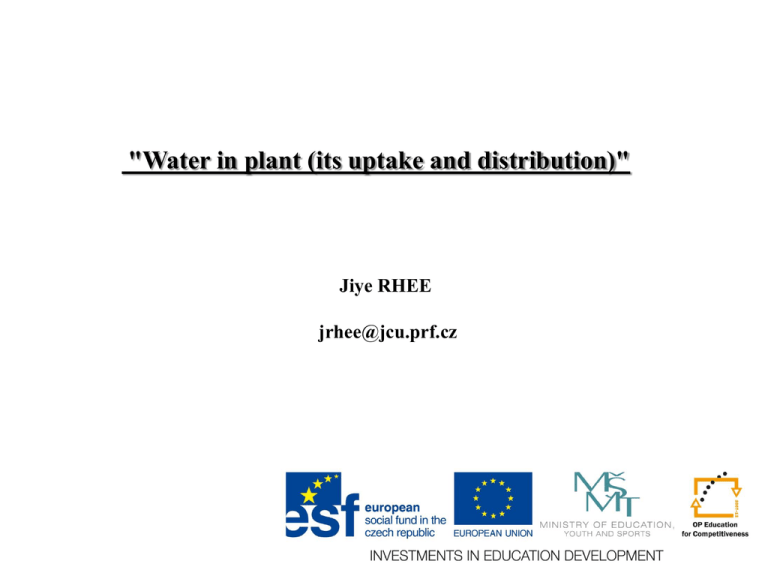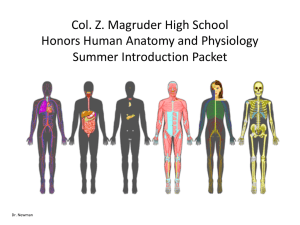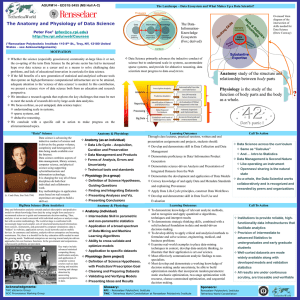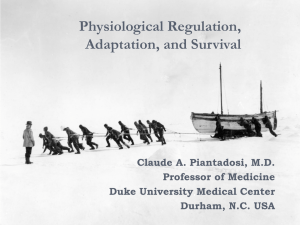Water in plant
advertisement

"Water in plant (its uptake and distribution)" Jiye RHEE jrhee@jcu.prf.cz KEBR562- Small plant physiology – Chapter : Water in plant 1. Water Balance of Plants 2. Water channel protein (Aquaporin) KEBR562- Small plant physiology – Chapter :Water in plant 1. Water Balance of Plants 2. Water channel protein (Aquaporin) - Differences in : Water vapor concentration Hydrostatic pressure Water potential KEBR562- Small plant physiology – Chapter : Water in plant - Water moves through soil by BULK FLOW - ‘ BULK FLOW’ - connected movement of groups of molecules all together, most often in response to a pressure gradient - Water absorption from Soil KEBR562- Small plant physiology – Chapter : Water in plant Plant roots KEBR562- Small plant physiology – Chapter : Water in plant - Water uptake in the roots 1. Apoplast pathway : water moves through cell walls without crossing any membranes 2. Transmembrane pathway : enter a cell on one side, exists the cell on the other side, enter next cell , and so on 3. Symplast pathway : via plasmodesmata - At the endodermis- Casparian Strip KEBR562- Small plant physiology – Chapter Water in plant KEBR562- Small plant physiology – Chapter : Water in plant KEBR562- Small plant physiology – Chapter : Water in plant Water transport through xylem - consist of two types of tracheary elements Tracheids Vessile elements KEBR562- Small plant physiology – Chapter : Water in plant Water transport through xylem - Plants can get embolism tool - Air bubbles can form in xylem - Cavitation KEBR562- Small plant physiology – Chapter : Water in plant Venation of a tobacco leaf - The tensions needed to pull water through the xylem are the result of evaporation of water from leaves KEBR562- Small plant physiology – Chapter : Water in plant Water evaporation in the leaf affect the xylem Tension or negative pressures originate in leaves Transpiration pull As the radius of curvature decreases, the pressure decreases (become more negative) KEBR562- Small plant physiology – Chapter : Water in plant Water pathway through the leaf KEBR562- Small plant physiology – Chapter : Water in plant Water vapor diffuse quickly in air Transpiration from the leaf depends on two factors: - One, Difference in water vapor concentration between leaf air paces and the atmosphere - Two, The diffusional resistance of the pathway from leaf to atmosphere Two components: - Leaf stomatal resistance - Boundary layer resistance KEBR562- Small plant physiology – Chapter : Water in plant Boundary layer resistance - Still air - Windy conditions KEBR562- Small plant physiology – Chapter : Water in plant Stomatal control Remember the way cuticle? - Regulate water loss in plants and the rate of CO2 uptake OPEN/CLOSED KEBR562- Small plant physiology – Chapter : Water in plant Stomatal guard cells Stomatal resistance can be controlled by opening and closing the stomatal pores. Specialized cells- The Guard cells Two main types : Monocot and grasses – Dumbbell shape, pore is a long slit Dicot – kidney shape Q: When water is limited or abundant? KEBR562- Small plant physiology – Chapter : Water in plant The radial alignment of the cellulose microfibrils (A) a kidney shape stoma (B) a glasslike stoma KEBR562- Small plant physiology – Chapter : Water in plant Representative overview of water potential and its components SOIL-PLANT-ATMOSPHERE continuum KEBR562- Small plant physiology – Chapter Water in plant Summary - Water is the essential medium of life - Land plants faced with dehydration by water loss to the atmosphere - There is a conflict between the need for water conservation and the need for CO2 assimilation - This determines much of the structure of land plants 1. extensive root system – to get water from soil 2. low resistance path way to get water to leaves – xylem 3. leaf cuticle – reduces evaporation 4. stomata – controls water loss and CO2 uptake 5. guard cells – control stomata KEBR562- Small plant physiology – Chapter : Water in plant 1. Water Balance of Plants 2. Water channel protein (Aquaporin) KEBR562- Small plant physiology – Chapter : Water in plant - Structure NPA motif, ar/R selectivity filter - Five main homologous subfamilies : Plasma membrane Intrinsic Protein (PIP) Tonoplast Intrinsic Protein (TIP) Nodulin-26 like Intrinsic Protein (NIP) Small basic Intrinsic Protein (SIP) X Intrinsic Protein (SIP) KEBR562- Small plant physiology – Chapter Water in plant Cell pressure probe Meniscus KEBR562- Small plant physiology – Chapter Water in plant Function expression of Aquaporin genes Xenopus oocyte KEBR562- Small plant physiology – Chapter Water in plant Relative volume 1.30 1.25 H2O 1.20 CuPIP1 FgPIP2 1.15 1.10 1.05 1.00 0.95 0 H2O FgPIP2 H2O CuPIP1 30 60 Time (sec) 90 120 KEBR562- Small plant physiology – Chapter Water in plant Questions 1. Explain, in terms of water potential how water moves from the soil to the endodermis in a root 2. Explain why, in summer, the diameter of a branch is smaller at noon than at midnight











